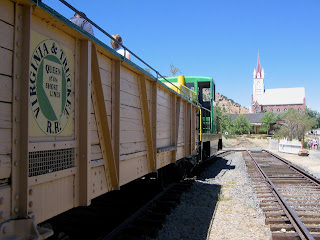 |
| Virginia & Truckee Railroad Today |
Railroads played an essential role in the development of the Silver State. In fact, if not for the development of the Central Pacific Railroad in the 1860s, Nevada might not even exist today.
The following are a few trivia questions related to Nevada’s railroads that are designed to test your knowledge of the state’s rich rail-related history.
Q: When did the first railroad locomotive enter Nevada?
A: On December 13, 1867, the first locomotive, from the Central Pacific Railroad, edged across the state line near present-day Verdi. Construction of the line, which started in Sacramento, California, had begun on January 8, 1863, and took five years due to difficulties in building over (and through) the Sierra Nevada range.
Q: What rail official was responsible for naming Reno?
A: Reno was named by Judge Edwin B. Crocker, attorney for the Central Pacific Railroad (and brother of Charles Crocker, superintendent of the railroad) in honor of General Jesse L. Reno, a Union officer killed in the battle of South Mountain, Maryland in 1862.
Q: What potential rival to the Central Pacific Railroad conducted a survey in 1862 for a rail line from Sacramento to Virginia City, via Placerville and Lake Tahoe?
A: The San Francisco and Washoe Railroad Company, incorporated in 1864, planned to build along a route roughly parallel to today's Highway 50. The line would have connected with the Placerville & Sacramento Valley and the Sacramento Valley railroads. The company envisioned eventually extending the line from Virginia City to Austin but never got off the ground.
Q: What Nevada railroad advertised itself as “Queen of the Short Lines?”
A: The famous Virginia & Truckee Railroad, which ran from Virginia City to Carson City to Reno (during its peak period), and included a branch line to Minden.
Q: What railroad name was apparently so popular it was used twice in two different parts of the state?
A: The name was the Nevada Central Railroad, which applied first to a shortline between Pioche and Bullionville that ran from 1872 to about 1883, then to a later, more successful line between Battle Mountain and Austin that operated from 1880 to 1938.
Q: What Northern Nevada town was created in 1902 after the Southern Pacific Railroad (formerly the Central Pacific) moved its shops and facilities there from Wadsworth?
A: The new company town was originally called "East Reno," then "New Reno," then, in 1903, "Harriman," after the President of the railroad. In 1905, it was officially incorporated as "Sparks," after then Governor John Sparks.
Q: What did Carson & Colorado Railroad owner Darius O. Mills once say about his railroad during an inspection tour of the line in 1883?
A: Mills arrived in Hawley, California in the Owens Valley, which at the time was the end of the 293-mile line that was supposed to continue to Mojave in Southern California. He scanned the sandy, dry desert along the eastern side of the valley—not near the more fertile agricultural region on the west side—and said the railroad had been built either 300 miles too long or 300 years too soon. The line did not extend beyond Hawley (later called Keeler) until after it was later sold to the Southern Pacific Railroad and its name was changed to the Nevada & California Railroad. The line survived until 1959.





